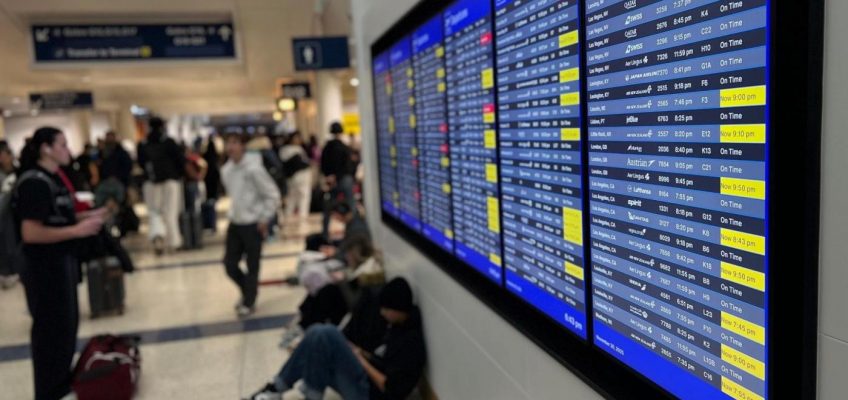By PATRICK WHITTLE and ADAM SCHRECK
PORTLAND, Maine (AP) — Black ice, snow showers and fog pestered post-holiday travelers in the Midwest on Monday while the Northeast geared up for its first major snowstorm of the season.
More than 8 inches of snow fell at Chicago O’Hare International Airport this weekend, setting a record for the highest single calendar day snowfall in November at the airport, according to the National Weather Service. The previous record was set in 1951.
About 300 flights into and out of O’Hare had been canceled by early Sunday evening, while about 1,600 had been delayed, according to the tracking site FlightAware. Dozens remained canceled or delayed there into Monday, and commuting conditions on roads were expected to remain dangerous in some areas well into Monday night.
In the Northeast, some parts of northern New England were expecting up to 10 inches of snow. A windy, potentially icy storm was headed to the region, and could soak some parts of the six states while piling snow in others, forecasters said.
And with plowable snow expected to coat large parts of Pennsylvania, crews began to treat snow lanes along the 565-mile Pennsylvania Turnpike system on Monday, said the agency’s press secretary, Marissa Orbanek. Vehicle restrictions on the turnpike system’s Northeast Extension, from the Lehigh Valley to Clarks Summit, will be imposed at 5 a.m. Tuesday.
More than 600 equipment operators and safety workers are available to help clear the turnpike’s 2,900 miles of snow lanes, Orbanek said. The turnpike’s winter staffing schedule began in mid-November, and 23 maintenance sheds are staffed around the clock.
“We really prepare for snow all year long,” Orbanek said.
In Chicago, Don Herrian was among the crowds of travelers at O’Hare on Sunday, hoping to make it back home after Thanksgiving as hundreds of flights were delayed and canceled following a winter storm in the Great Lakes region.
The 76-year-old retiree from Ardmore, Oklahoma, had visited his daughter and her family in Indianapolis. He said his first flight was three hours late, and his connecting flight to Oklahoma City from Chicago was already running another two hours behind.
“It is what it is,” Herrian said. “It’s congested, but that’s expected due to the snow, the delays and the holidays.”
Related Articles
What is GivingTuesday? How to donate on the annual day of charitable giving
Starbucks to pay about $35M to NYC workers to settle claims it violated labor law
Son of ‘El Chapo’ is set for a change-of-plea hearing in US drug case
When formal systems stop working, neighbors turn to each other in what many call ‘mutual aid’
How to watch the last supermoon of the year
Roads leading to O’Hare were packed Sunday with slow-moving vehicles even after the roads had been cleared of snow. Inside, delayed travelers crowded into gate seating areas, restaurants and sports bars to pass the time. Others grabbed spots on the floors of the terminals, snacking, knitting or scrolling their phones.
Planes were being de-iced at several airports across the country on Sunday, including at Ronald Reagan Washington National Airport and Minneapolis–Saint Paul International Airport, according to the Federal Aviation Administration.
Over 12 inches of snow had fallen since Saturday in areas close to Lake Michigan. Hundreds of churches in western Michigan told worshippers to stay home or watch services online.
In Wisconsin, utility crews worked to restore power to thousands of people. We Energies reported more than 6,000 power outages, with more than half in Milwaukee and South Milwaukee. The airport in Des Moines, Iowa, reopened on the critical travel day after a Delta Connection flight landing from Detroit slid off an icy runway. No injuries were reported, and passengers were transported to the terminal by bus.
By early Sunday evening, over 400 flights into and out of Detroit Metro Airport were delayed and over 45 were canceled, according to FlightAware.
Elsewhere in Iowa, gusty winds on Sunday were blowing snow back onto roads, extending hazardous travel conditions, the National Weather Service said.
“We did have areas of Iowa and Illinois that saw over one foot of snow,” said meteorologist Andrew Orrison.
Over 16 inches of snow fell in Fort Dodge, Iowa, according to the National Weather Service.
Orrison said snow in the Great Lakes region was tapering off, but the new storm was heading to the mid-Atlantic and Northeast, with up to a foot (30 centimeters) of snow by Tuesday.
“It’s going to be the first snowfall of the season for many of these areas, and it’s going to be rather significant,” Orrison said. “The good news is that it does not look like the major cities at this point are going to be looking at any significant snowfall.”
Schreck reported from Chicago. Associated Press reporters Jamie Stengle in Dallas and Mark Scolforo in Harrisburg, Pennsylvania, and photojournalist Nam Y. Huh in Chicago contributed to this report.




